 Category: Blog
Category: Blog
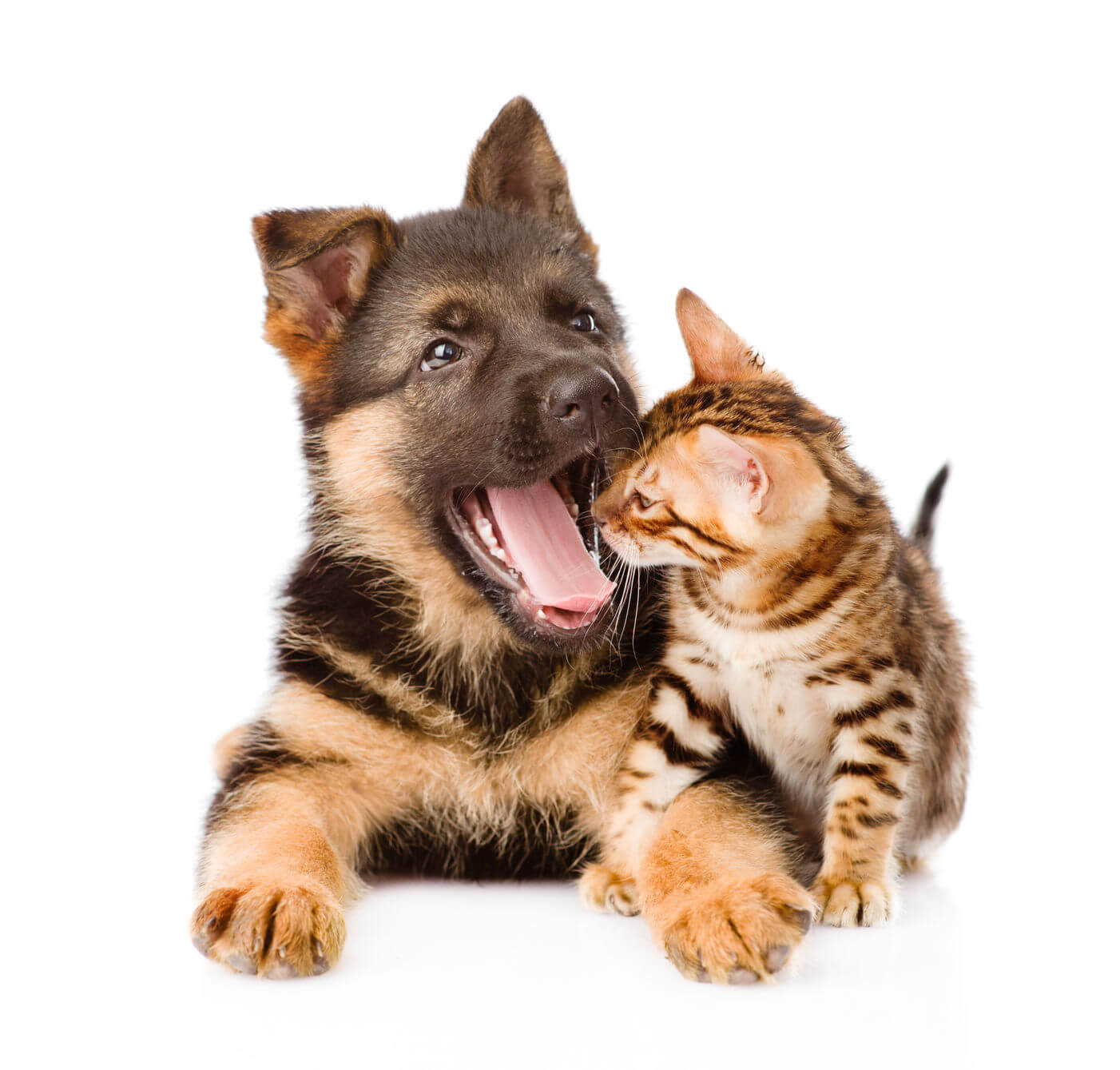
Dental Hygiene Myths
As part of February’s dental awareness month, we thought it would be a great idea to go through the common myths most clients believe when it comes to their cat/dog’s oral health.
We know that a lot of pet owners think that their pet will be fine without regular dental cleanings/exams. This is untrue, pets need just as much dental attention as us humans do.
Myths convince pet owners that annual cleanings and checkups are unnecessary. Here are the top 4 myths that every pet owner should stop believing.
- Certain bones and treats are good for my pet’s teeth and help prevent plaque build up so it’s unnecessary for him/her to have a cleaning.
Some bones can cause fractured teeth and cause injuries. Treats like kibble help remove plaque from the top of your pet’s teeth but what about the barrier of their teeth and gums? There’s no treat or toy that can clean the hard to reach area in your pet’s mouth. Gums are very important to clean in order to avoid gingivitis and diseases like periodontal disease.
- My pet’s breath smells because he/she is suppose to have bad breath.
Bad breath is common in cats and dogs but very bad breath can be a cause for concern. A cat/dog’s breath can begin to smell poorly if his/her gums are in poor condition or if there’s gingivitis build up.
- I’ll know if my pet is experiencing pain in his/her mouth if he/she doesn’t eat.
Although we think of our pets as our furry babies, we have to remember that cats and dogs are animals and animals have different instincts when it comes to survival. Cats and dogs generally hide their pain until it’s completely unbearable. He/she will continue to eat even if they’re in pain. If your pet isn’t eating at all the pain has become very severe and can possibly be the outcome of a serious issue. You can prevent your pet from experiencing severe pain through routine cleanings/exams.
- I don’t have to brush my pet’s teeth.
Just like humans, cats and dogs need daily oral cleaning. After an oral examination the vet will explain to you how to clean your pet’s teeth at home.
It’s time to stop believing all the myths and begin taking care of your pet’s needs.
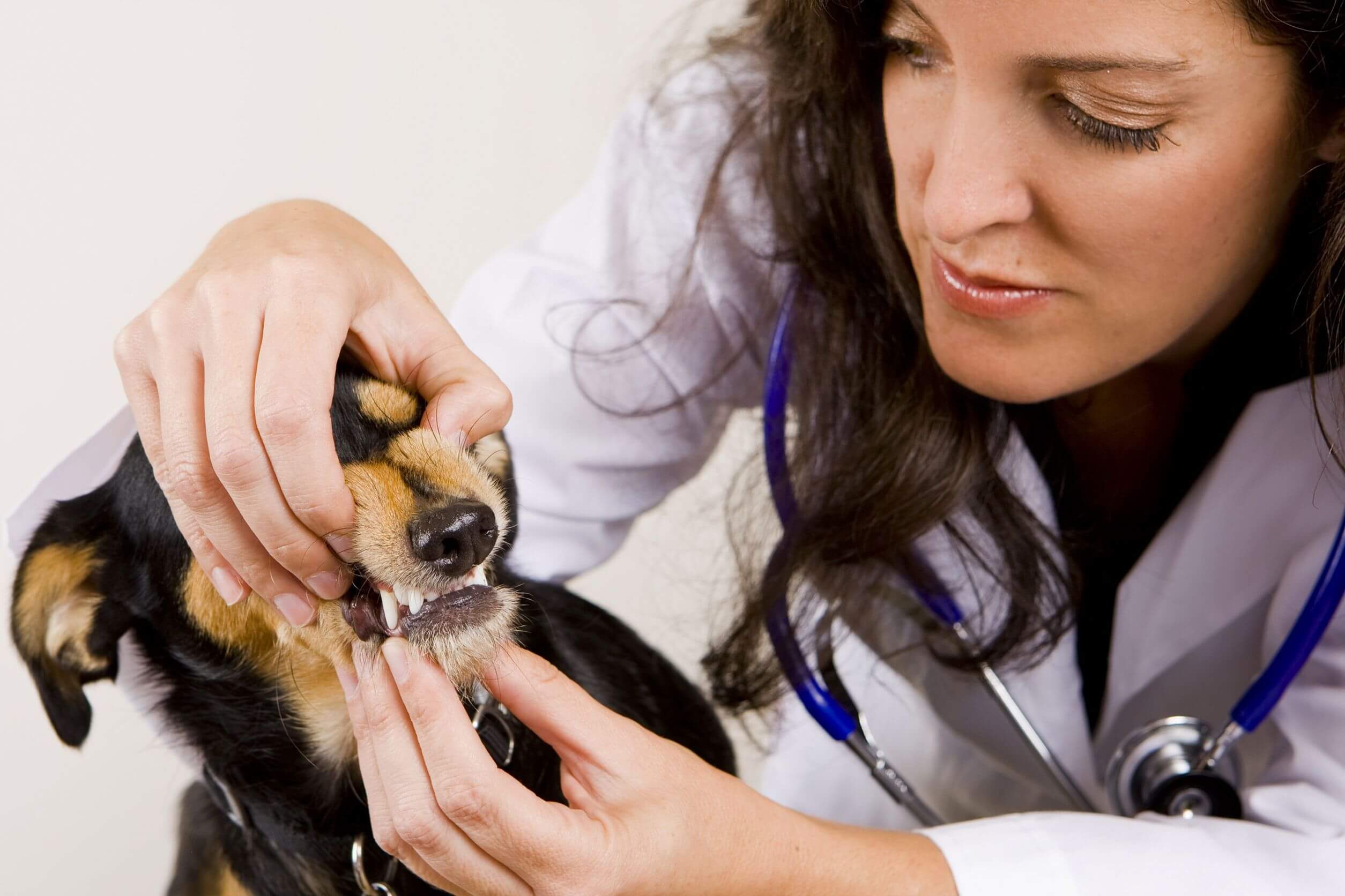
Is it Really that Important to Have your Pet’s Teeth Cleaned Regularly?
February is dental awareness month and Centre Street Animal Hospital has the answers to all your questions.
A lot of clients ask if it really is that important to have their pet’s teeth checked and cleaned on a regular basis. The answer is yes! Routine dental check ups for your cat/dog are very important in maintaining his/her oral health. We recommend for your pet to receive a dental cleaning/examination at least once a year.
Periodontal disease is a big concern when it comes to your cat/dog’s oral health. Periodontal disease is an infection around the teeth which includes the gums, periodontal ligament and alveolar bone. This disease begins with the development of gingivitis. Routine cleanings/examinations will help prevent periodontal disease by keeping gingivitis under control.
In addition, a cleaning allows for your pet to get a complete oral examination. This is the most important reason for annual dental check ups. Remember, your fur baby is an animal, when they feel pain their instinctive behaviour is to not show it. If your pet is feeling pain in his/her mouth you will never know until he/she undergoes a complete examination.
Regular dental checkups and cleanings are the ingredients to good overall health for your pet!

Reasons to Microchip Your Pet
No pet-owner wants to think about the possibility of losing their furry friend, but the truth of the matter is, sometimes dogs and cats go missing.
While the majority of Canadians do not microchip their pets, the statistics show that dogs and cats are over 10 times more likely to be returned to their families if they are microchipped.
If you are considering microchipping your cat or dog, good for you! Here are some facts to help convince you as to why it’s a good idea:
It doesn’t hurt
A common misconception about microchipping is that it is a painful procedure for your pet to have to endure. Rest assured that microchipping is not major surgery. The microchip is very small (about the size of a grain of rice) and it is inserted between your pet’s shoulder blades (the scruff) with a needle. The scruff is not a very sensitive area on your dog or cat, plus some veterinarians apply a local anesthetic so they will barely feel a thing.
As with any procedure that involves inserting a foreign object into a body, you’ll want to keep an eye on the area of insertion for unusual growths or lumps, but these are unlikely complications.
It’s not expensive
Contrary to popular belief, microchipping your cat or dog is not expensive. It usually costs about $75.50 to have your pet Microchipped. When you consider the peace of mind it will bring you, it is actually a very sound investment.
Collars and tags come off
You should absolutely put a collar and tag on your pet, as this is the most obvious way to identify them.
However, pets can go on some pretty wild adventures when you’re not looking, and collars and tags can easily come off. In fact, easy-release collars are often encouraged for certain pets (especially outdoor cats) to avoid the risk of entrapment or choking.
Having a microchip inserted into your dog or cat is a surefire backup when keeping your dog or cat’s identity intact.
“Missing” pets are sometimes actually “stolen”
If you’re an animal lover – and no doubt you are if you’re reading this – it will be hard for you to imagine how anyone could actually steal a beloved pet from someone else. Sadly, these people exist. A thief can easily remove your dog or cat’s collar and tags, and if you find yourself needing to prove that the pet is indeed yours, the microchip will come through for you.
Shelters are crowded
We applaud animal shelter workers for their hard work and diligence trying to keep lost and stray animals off the streets. However, despite best efforts, a vast number of animal shelters are horribly overcrowded. In many cases, they can only take care of an unclaimed cat or dog for so long.
When a lost pet is taken to a shelter, one of the first things that a shelter worker will do is scan the cat or dog for a microchip. If your pet ends up at a shelter, their days may be numbered unless they are microchipped.
Now that you know the facts, are you thinking of getting your pet microchipped? Wise decision! Contact our clinic today for an appointment!
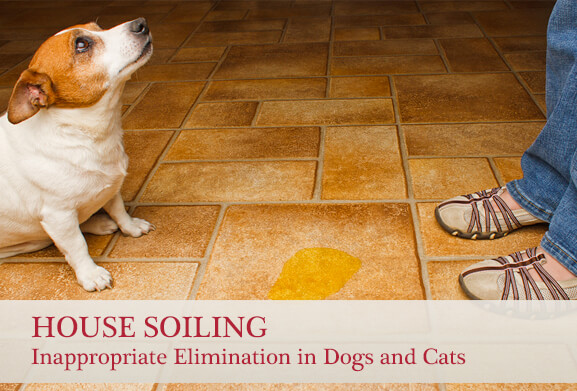
House soiling: Inappropriate Elimination in Dogs and Cats
No matter how much you love your dog or cat, having a pet who eliminates in the house is frustrating to the pet owner. If you have a problem with your dog or cat eliminating on your floors, furniture or even walls, you need to stop the behavior before it escalates. A little understanding about the causes of the problem, and the steps to take to prevent and stop it, can help.
Rule Out Any Medical Problems
If a dog or cat that has been properly trained to eliminate outside or in the litter box suddenly starts urinating or defecating in the house, the behavior can point to a medical problem. Urinary tract infections, kidney disease, thyroid problems, mental problems and diabetes, all of which can affect pets, can cause house soiling. If you suspect a medical problem or the house soiling starts suddenly, consult with your veterinarian to ensure there is not a medical issue.
House Soiling for Dogs – Common Reasons
For dogs with no underlying medical issue, urinating or defecating inside the house is typically a behavioral issue. Common behavior problems that cause this behavior include:
- Marking of territory
- Separation anxiety
- Excitement urination
- Submission urination
- Urinating or defecating because of anxiety
In addition, inadequate house training can lead to problems with house soiling.
House Soiling in Dogs – Solutions
If the problem stems from territorial marking, and your dog has not been spayed or neutered, then having the dog fixed can help. For most of the other problems, the solution is additional training. The goal is to teach the dog to eliminate in the right place and the right time.
First, determine if your dog has specific times that he is likely to need to go. Try to take your dog outside during these times. When he eliminates outside, offer praise and a treat. In order to praise the behavior, you have to be outside with your dog when he is given his chance to go. If you catch your dog going in the house, clap loudly to startle him and stop the process, then take him immediately outside to finish eliminating. Do not punish the behavior, no matter how frustrating it is, as this can cause your dog to hide when he is going, creating more problems.
For house soiling that occurs due to submission, anxiety or excitement, talk to your vet about proper training options to eliminate this behavior. Your dog may need anti-anxiety medications, or you may need to avoid situations that cause extreme excitement or submission behavior.
House Soiling in Cats – Causes
Causes for house soiling in cats can be quite varied. Look for problems like:
- New litter causing litter box aversion
- Moving the litter box
- Litter box aversion due to a negative experience in the box
- Inappropriate site preference
Spraying is slightly different then urinating and is done when the cat is standing up. Spraying is a marking behavior and tends to occur with unneutered males and unspayed females, but a small number of neutered or spayed cats will spray as well.
House Soiling in Cats – Solutions
If your cat is suddenly avoiding the litter box, consider if something, like the litter or the location of the box, has changed. Also, if your cat had a traumatic experience or pain while using the litter box, going back in can be hard for him. To eliminate this aversion, make sure the litter box is how it has always been, and also make sure your cat can see around him while using the box. You may prefer a covered box, but your cat can find it frightening.
For cats showing a preference to a certain surface, you may not be able to change the behavior. Consider if there is a way to change the litter to match the surface, such as placing a carpet remnant in the litter box or adding an old shirt.
If you catch your cat in the act of soiling in the house, avoid reaction. Negative reinforcement, such as spraying the cat with water, is only effective if you catch the cat starting to urinate or defecate, and you must deliver the punishment every time. Catching your cat every time he goes is nearly impossible, so it’s best to just ignore the unwanted behavior and encourage proper elimination.
If your cat is spraying, consider spaying or neutering to help with the problem. If the cat is already fixed, try to remove stimuli that cause marking behaviors. Clean any areas that have been sprayed using odor neutralizing cleaner to prevent repeat behavior.
House soiling is, understandably, a frustrating problem. If you are having this problem with your dog or cat, consult with your vet to rule out health problems and create a training or scheduling routine that will help teach proper behavior.

Five New Years resolutions for your pet
It’s the New Year, and with this comes a desire to make some resolutions as you look to better yourself and your health in the coming year. If you are a pet owner, why not make some New Year’s resolutions that include your pet? Make 2015 the best year yet for your pet with these pet health New Year’s resolutions.
1. Get Your Pet in Shape
Did you know that around half of all of today’s pets are overweight? Weight has a tremendous impact on pet health. Whether your pet is part of that statistic or not, make 2015 the year that you ensure that your pet stays at a healthy weight. There are two main ways to do this.
First, take a look at what your pet is eating. Do you leave food out all day for your pet to graze on, or do you limit the amount of food you serve? Free feeding encourages overeating and eating while bored. Instead, feed your pet the amount recommended by your vet two times a day. After 20 minutes, remove uneaten food. Your pet will not go hungry, and you will notice that after a few days he starts gobbling up that food quickly when it is put out.
Next, consider the amount of exercise your pet gets. All pets have different exercise needs, depending on their weight, health age and breed. Talk to your vet about the amount of exercise your pet needs, but make sure you are providing enough.
2. Resolve to Make Dental Hygiene a Priority
How are your pet’s teeth? Pets need dental care just like humans. If your pet’s teeth are in poor shape, make a resolution that this is the year you will visit the vet for a dental checkup. If your pet’s teeth are doing great, make a resolution that you will keep them that way.
You can do your part to help at home too. Make sure you are providing your pet with regular tooth brushing at home. If you are not in the habit of doing this, your pet may resist at first. Make the experience positive with much praise and plenty of treats, and you will soon find that it’s a task both of you look forward to.
3. Invest in Some Training
How is training going with your pet? While all pets can benefit from training, dogs especially need training to ensure that they are well-behaved members of your family. Make a resolution that 2015 is the year that you make dog training a true priority.
Training is good for both of you. Your pet will enjoy having the mental stimulation and bonding time that training sessions provide. Also, bad habits, like digging, chewing and barking, can easily be helped with the right training. In the end, you will have a well-mannered, well-trained pet that is a joy to have in your family, and you may have fun teaching a few new behaviors too.
If you are in need of professional training, talk to your veterinarian about training options near you. Not all training programs are created equal, so you will want to find a quality trainer that will give you and your pet the positive experience you both desire.
4. Keep Your Pet Identifiable
Is your pet micro-chipped? Does he wear a collar with identification that will get him back to you if he is lost? It only takes a second for a pet to run off and get lost, and without the proper identification, you may not get him back. Even the most mild-mannered pets can be tempted to take off after a squirrel or rabbit, so do what you can to protect your pet this year with proper identification.
Take the time to update contact information if your pet is micro-chipped. If your pet is not micro-chipped, consider having it done. It can mean the difference between getting your pet returned to you if he runs off, and losing him, and the microchip is relatively affordable.
5. Make 2015 the Year of Play
Do you remember why you got your pet in the first place? Chances are you wanted a playmate and companion. Have you forgotten to take the time to play now that you have had your pet for a few years? If so, make a commitment to play in 2015.
At first, if your life is busy, you may need to schedule this time, but it will be well worthwhile if you do. Soon both you and your pet will be looking forward to your daily play time. As a side benefit, you will both get emotional and physical benefits as you engage in relaxing play, which doubles as physical activity for both of you.
Do you have other ideas about how you can improve your pet’s health and well-being in the coming year? Come to our clinic to discuss your pet health New Year’s resolution ideas with our veterinary staff, and let us help you make 2015 the best year for your pet’s health!
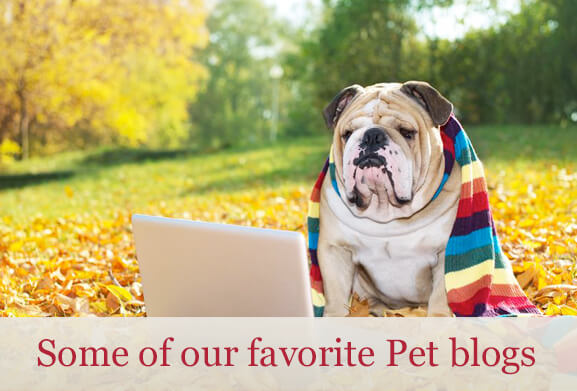
Some of our favorite Pet blogs
Where can you go to learn more about your pets and being a responsible pet owner? The Internet provides a wealth of information on pets and pet ownership, but you do need to dig through what you can find to get the best possible information and support. Here are some blogs that we feel are the best you will find online. If you are looking for help as a pet owner, this is where you should start.
Ontario SPCA Blog
The Ontario SPCA blog is a great resource written by people who love pets and work hard day in and day out to protect them. You will find humor, tips, tricks and local information for pet owners. The blog will also keep you informed about SPCA news and fundraising efforts, so you can give your support.
There’s a Cat in the Fridge
Why does it seem like all pet blogs are focused on dogs? Cat owners will love There’s a Cat in the Fridge. It focuses on help, support and humor for cat owners and those interested in adopting a cat companion.
The Lazy Pit Bull
The Lazy Pit Bull is filled with tales of dogs and, more specifically pit bulls. Inspired by Nike Jayne, a Pit Bull/Boxer mix, The Lazy Pit Bull will keep you laughing while providing tips on building a pet-friendly life.
Go Pet Friendly
Go Pet Friendly’s blog will teach you everything you need to know about traveling with a pet. While the focus is primarily on traveling with a dog or cat, you will find information about traveling with other types of pets as well.
Petfinder
Petfinder is a service that helps pet lovers find adoptable pets near them by searching by location, breed, age, gender and more. Petfinder also has a blog that provides information about all aspects of pet ownership.
The Farley Foundation
The Farley Foundation assists needy pet owners with the costs of veterinary care for their beloved pet companions. The organization was established by the Ontario Veterinary Medical Association. The Farley Foundation’s blog offers support, information and heartfelt stories for pet owners of all types.
Wet Paw Design
Wet Paw Design makes pet beds, toys and apparel out of organic, pet-safe and eco-friendly materials. While not a blog, per se, this is a website we can wholeheartedly recommend when you are shopping for a something special for your pet.
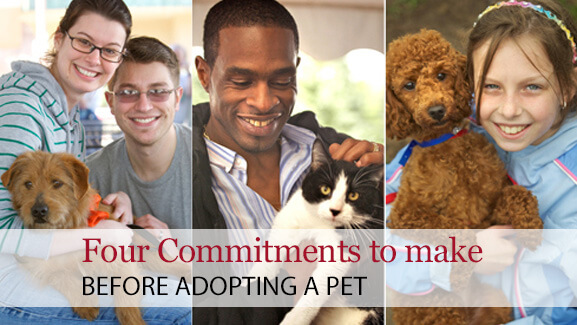
4 Commitments to make before adopting a pet
Are you considering adopting a pet? Adopting can be a very rewarding way to bring a new pet into your home. Your new pet will become a life long companion, best friend and playmate. Yet, adopting a pet needs to be done with careful research to ensure that you are ready for the commitment and the changes your new pet will bring to you. With a little bit of research and a lot of love, your pet can become a beloved member of the family, providing emotional and even physical benefits for you and your family members. Here are four key commitments to be ready for when you adopt a pet.
1. A Financial Commitment
While the emotional benefits of owning a pet outweigh any financial cost, there’s no denying that owning a pet costs money. Even if you already own a pet, bringing another one into your home will increase your costs for pet care. Here’s an estimate of what you will pay a year for your new friend.
- Veterinary care and vaccinations: $480 for a cat, $720 for a dog
- Food: $480 for a cat, $720 for a dog
- Toys: $26 for a cat, $41 for a dog
- License: $30 for a dog
- Litter: $144 for a cat
- Treats: $40 for a cat, $66 for a dog
Keep in mind that your pet’s breed can affect the total cost of ownership as well. A large dog, for example, will require more food than a toy breed, but many toy breeds require ongoing grooming to keep their coats soft and free of tangles. Talk to your vet or a pet rescue about the needs of the breed you are considering.
2. A Responsibility Commitment
Bringing home a pet is a new responsibility. You are committing to play with that pet, take care of its physical needs, ensure that it is loved and well fed. While most pet owners will agree that these responsibilities are enjoyable and the rewards they get from their pets far outweigh the work they have to put in, it’s important to research these responsibilities before you make the decision to adopt. Don’t worry, though. When you have that happy face waiting for you at the end of a long day at work, you will be more than happy to embrace that responsibility!
3. A Lifestyle Change Commitment
Sometimes your lifestyle will need to adjust to accommodate the new pet in your life. If you have never owned a pet before, be ready for a learning curve. It will take both you and the pet some time to figure out your routine. If you already own pets, adopting a new dog or cat will create an adjustment period for everyone.
To help you with this adjustment period and potential lifestyle change, talk to your veterinarian or a pet expert about the pet you are considering. Find out what its needs are, and take a look at your lifestyle. Can you accommodate the pet’s need for socialization, exercise and entertainment? Can you make a few adjustments to open your heart and home to this new family member? Going in with your eyes wide open will help you make the best choice, both for you and for your new pet.
4. A Commitment to Research
Finally, before deciding to adopt a pet, commit to doing your research! Find out all you can about the type of animal and the breed you are considering. You will be surprised at the differences between various breeds and pets available. With some time to research, you should be able to find a pet that will be a great fit for your family.
As you research, make sure you talk to the right people. Shelter staff and veterinarians are a good source of information, because these professionals are committed to making the right matches between pet and owner, not simply looking to sell a pet they no longer want.
When adopting, you will also want to talk to the shelter about the pet’s history. Some pets have unique needs, and you want to be certain you can embrace those needs. For instance, if you are considering adopting a pet that does not do well with other pets, and you already own pets, you may want to choose a different one. On the other hand, the shelter may tell you that the pet you are considering is great with kids, and you may have a house full of kids! This background information will give you peace of mind that the pet is the right choice for you.
Adopting a pet is an emotionally fulfilling journey for pet owners. You will be bringing your new best friend home, giving him a new lease on life! Just make sure you consider these four commitments, do your research and make an informed decision for the best possible journey for both of you!
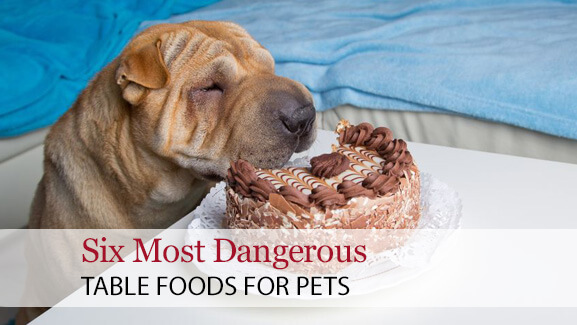
Six most dangerous table foods for pets
Do you regularly feed your pet from your plate? While this might seem like a special treat, some table foods are quite dangerous. The next time you do, make sure you aren’t giving him one of these dangerous foods for pets.
Chocolate
When your dog’s birthday rolls around, ditch the chocolate cake in favour of something more pet-friendly. The caffeine and theobromine in chocolate are both harmful to pets, causing over-stimulation. This leads to vomiting, diarrhea, accelerated heart rate, restlessness and over-activity. Toxicity can progress into seizures, hyperthermia and, without treatment death. If your pet consumes too much chocolate, you need to visit the vet immediately. The vet has only a small window of time in which to induce vomiting to cleanse the body of the chocolate. If too much time passes, your pet will need to be hospitalized and monitored for signs of toxicity in order to protect his life.
Chocolate toxicity is one of the most common toxicities seen today, and sadly leads to fatalities often because owners do not seek medical treatment quickly enough. If your dog has gotten into some chocolate, do not delay. Head to the vet right away! Avoid giving your dog chocolate, and keep the chocolate you eat out of reach.
Grapes
Grapes, as well as raisins and other pitted fruits, are another dangerous table food. Researchers have not been able to identify the specific toxin in grapes and similar fruits, but they cannot deny that these fruits cause serious problems for pets. If your pet gets into some grapes, you may notice lethargic behaviour. Some pets will also vomit, and a few will suffer from kidney failure, which can be fatal.
You may be thinking that your pet eats grapes frequently without a problem. This is the interesting fact about this toxic food. Some dogs and cats can eat them without a problem. Others appear to have no trouble with these fruits, only to have a serious reaction when consuming them again after safely eating them multiple times. Yet some will develop an immediate reaction the first time they eat the fruits.
So how can you know if grapes are a problem for your pet, and should you be worried if your pet accidentally eats some? There is no way to know which pets will have a reaction, so it’s best to avoid the food altogether. If your dog or cat accidentally consumes grapes, any toxicity problems will happen within 12 hours of eating the fruit. If you notice lethargy or stomach upset after eating grapes, get medical attention right away to avoid kidney failure, which can be fatal.
Avocado
Avocado plants, including the skin, fruit, seeds, leaves and bark, contain persin, a toxin that is dangerous to pets. Pets of all types, not just dogs and cats, can experience respiratory distress and fluid accumulation on the heart after eating an avocado. To add to the risk this fruit poses, the pit, which is not digestible, can cause gastrointestinal blockages if consumed on accident. Because avocados are one of the most dangerous foods for pets, keep them away from your furry and feathered friends.
Raw Meat and Bones
In the wild, dogs and cats would be consuming raw meat to survive, but meat that has been processed and put in the grocery store is not fresh in the way meat in the wild would be. As a result, it is more likely to have bacteria, like salmonella and E. Coli, that pose a deadly risk. Also, many types of bones are brittle and can splinter in your pet’s stomach.
If you want to feed your pet meat, simply cook it first to destroy the bacteria. If your dog loves to chew on bones, avoid the risk from real bones and invest in bones prepared for this purpose at the pet store.
Xylitol
Gum, sugar free candies and even sugar free cookies are often made with xylitol, a common artificial sweetener. Keep these tempting treats away from your pet, as xylitol is highly toxic to pets. It can cause seizures, liver failure, loss of coordination and lethargy. This risk is so high that you should visit the emergency vet if you notice any of these symptoms after your pet has consumed a product with xylitol. Keep your sugar-free treats well out of your pet’s reach. It’s simply not worth the risk.
Garlic and Onions
Garlic and onions also appear on the list of most dangerous foods for your pet. While you probably won’t find your pet consuming onions and garlic raw, as the smell is a deterrent, you may be tempted to give your pet foods that were cooked with these ingredients. Also, concentrated forms, like onion soup mixes, can be enticing to pets. These concentrated forms have extremely high quantities of these foods. If ingested, compounds in these foods can damage your pet’s red blood cells.
While a few pieces in a prepared food are not a problem, a large amount of onions or garlic can create serious problems. If your pet eats them, you may not notice symptoms until three to five days later. Symptoms may include lethargy, no energy for exercise and orange-tinted urine.
Giving your pet table scraps can be a fun way to bond, and, in moderation, is usually not a problem. However, you need to know about the foods that can be potentially toxic. Avoid these dangerous foods for pets, and your pet will enjoy a long, healthy life free from toxins.

Health Benefits of Being a Pet Owner
You already know that owning a pet brings great joy to you and your family, but did you know that pet ownership actually carries health benefits? If you own a pet, you may already be experiencing some of these common pet health benefits. If you don’t own one, then these are excellent reasons to consider getting one!
Improved Allergies for Children
Allergies and pets may seem like they don’t mix well, but actually research has found that owning pets can help lower the risk of allergies and asthma for children in your home. A pediatrician published in the Journal of Allergy and Clinical Immunology found that children who grow up with pets in the home or who live on a farm and help with farm animals have a lower risk of asthma and allergies than children who were not regularly in contact with animals. Owning a pet is not going to make your adult allergies better, but one of the clear pet health benefits for children is a lowered risk for developing animal allergies later in life.
Fewer Problems with Weight
Do you need to lose a few pounds? Getting a pet might help. When you own a pet, that pet relies on you for exercise. Taking the dog for a walk or getting down on the floor to play with the kitten is exercise for both you and for your pet. This exercise benefits your waistline and helps you lose or keep off weight.
Lowered Stress Levels
People who own pets have lower stress levels than those who do not. In 2002, the State University of New York at Buffalo performed a study on this phenomenon. The researchers found that having a pet nearby when facing a major stress, such as a stay in the hospital, lowered stress levels more than the presence of a spouse or close friend.
Better Heart Health
When you walk into the kitchen to find that your dog has thrown the trash around the room again, you might not find yourself thinking that pets are good for your heart as you feel your blood pressure rising. Yet, pets have been shown to reduce heart disease risks in numerous studies.
For example, research has shown that people who suffer from a heart attack will live longer afterward if they have a pet at home. Also, men who own pets are less likely to develop risk factors for heart disease, such as high cholesterol levels or triglyceride levels. Lowered stress, which is one of the main pet health benefits, also lowers blood pressure. All of this adds up to a healthier heart and overall cardiovascular system.
Reduction of Pain
While researchers have not yet found a medical reason for this phenomenon, they have found that spending time with a pet can help lower pain levels. Patients who suffer from chronic pain problems report reduced pain after spending time with pets. Pet therapy is effective at reducing both pain and anxiety for post-operative patients, and patients who participate in pet therapy typically request less pain medication than those who do not. Arthritis sufferers often report lower levels of pain if they own a pet compared to patients who did not own pets.
Improved Mood
When you have less pain, less anxiety and less stress, your mood is automatically boosted. People who own pets have more joy in their lives from their animals, and this translates into a better overall mood. For those experiencing stress or trauma, that mood boost is even more significant, because it makes handling their problems just a little easier.
Social Benefits
Heart disease, anxiety problems and chronic pain can all be helped through pet ownership, yet people also experience benefits socially when they own a pet. When you take your pet on a walk, people often will stop and talk with you.
Pet owners are more socially engaged than those who do not have pets because they are in the community interacting with their neighbors. They also spend time going to the dog park, the groomer, the pet store and the vet, giving them opportunities to meet people who have a similar interest in pets, pet health and companion animals.
Whether you enjoy an improved social life or better cardiovascular health and a shrinking waistline, owning a pet is good for you! Why not reward your pet for the health benefits he provides with an extra walk today?
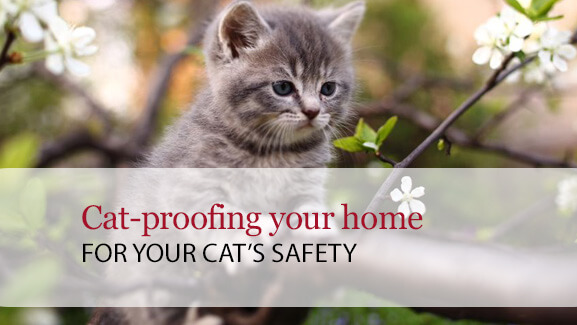
Cat-proofing your home for your cat’s safety
Cats are notoriously curious creatures and, much like toddlers, are constantly getting into things they should not be. Sometimes the result is nothing more than frustration for the owner and a bit of a mess, but other times the results can be devastating. Many normal household items can make cats quite sick, and that’s why caring for cats means cat-proofing the home. Here are some tips to make your home as safe as possible for your cat.
Watch for Poisons
One of the biggest risks for all pets, cats included, is poisons in the home. Now you likely know about the dangers posed by household chemicals and cleaners, and already keep those out of reach, but have you thought about the fact that your cat gets those chemicals on her paws, then sits down and licks those paws? Make sure that you are cleaning as naturally as possible, and when heavy-duty chemicals must be used, keep your cat out of the area until it has dried and ventilated.
Consider, for example, plants. Your houseplants, and the plants in your garden if your cat spends time outside, are tantalizing to your pet. Yet some of these, including rhododendrons, sago palms, lilies, schefflera, kalanchoe and azalea, are dangerous and even potentially fatal if ingested.
At Christmas time, poinsettias are another risk. Even cut flowers you bring into your home, like roses, can upset your cat’s digestive system if ingested. Make sure that you put any plants up and out of reach or in a cat-free area of your home. Also, remember that cats are excellent jumpers and climbers, so the safest option may be to have one room in the home that is designated as a no-cat zone.
Human food can also pose a danger. Caring for cats properly means avoiding table scraps, but sometimes cats will get into food you did not intend for them to have. Grapes, gum, avocado and chocolate are some of the more dangerous people “food” items that your cat may get tempted by. Make sure they are not accessible, and remember that your purse is not a safe place to stash gum unless you keep the purse off the floor and out of the reach of curious paws.
Watch for Strangulation Hazards
You know how you love to play with your cat by holding a toy on a string and letting him chase it? Consider other items in your home that look just like that toy on a string. The tassel on the end of your Venetian blind cords, for example, is quite tempting. Yet, when your cat gets tangled up in these, the results can be deadly. Your cat can strangle to death before you ever knew she was missing.
How can you prevent this? First, work to train your cat not to mess with the blinds, but as you know training cats is not as easy as it sounds. You also need to do what you can to prevent the problem by cat-proofing the blinds. Either get the cords up and out of reach, or invest in a chain connector that will break away from the blinds if too much pressure is put on the cord. These products are commonly sold in child safety areas of stores.
The chain or string on the blinds is just one such strangulation risk. Any cord, including electrical cords, that hangs down is tempting to a cat and will get played with, so you need to keep them up and out of reach. Electrical cords are also a danger if they are chewed, because they can shock your cat or leave exposed wires that are a danger to everyone in the home. Wrap up cords or tuck them out of sight to avoid any dangers.
Cat Choking Hazards
In addition to strangulation, you have to worry about choking and suffocation hazards with cats. Items, like plastic bags and even tinsel on your Christmas tree, that make a lot of noise are tempting to cats. They play with these items and run the risk of suffocation or strangulation. Ingesting these items, if it does not cause the cat to choke, can cause an intestinal blockage that is costly to fix and potentially life threatening. Keep tempting items like these up and out of the way.
Caring for cats means learning to think like one. Look around your home from your cat’s perspective, and see what might be appealing to him, and potentially dangerous. Cat-proofing your home will ensure that you all enjoy a long, healthy life together, without undue risks and an unexpected and heart-breaking tragedy.

